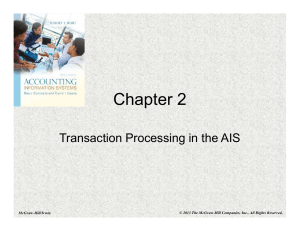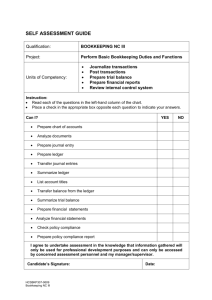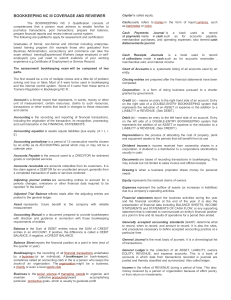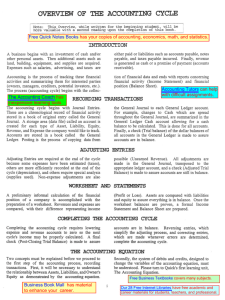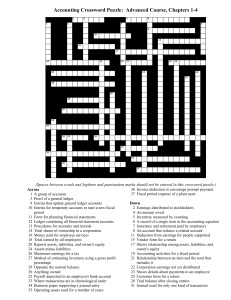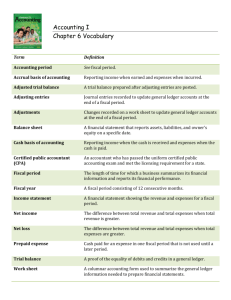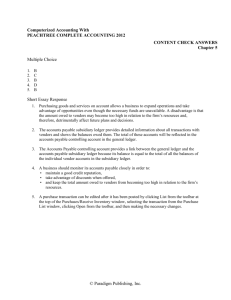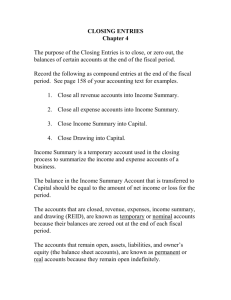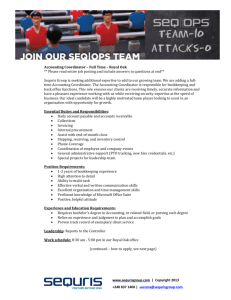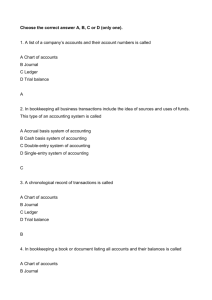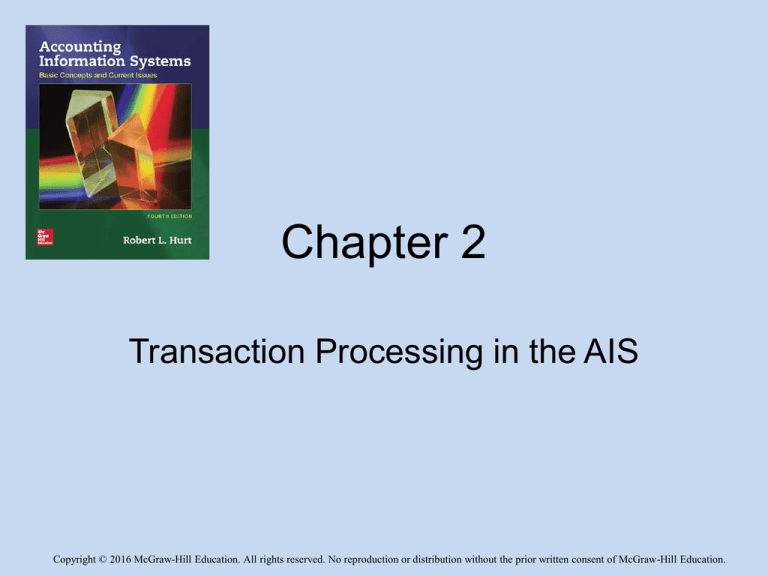
Chapter 2
Transaction Processing in the AIS
Copyright © 2016 McGraw-Hill Education. All rights reserved. No reproduction or distribution without the prior written consent of McGraw-Hill Education.
Outline
• Learning objectives
• Accounting and bookkeeping
• Accounting cycle
• Internal controls
• Coding systems
• Human judgment and information
technology
2-2
Learning objectives
1. Differentiate accounting and bookkeeping.
2. List, discuss and complete, in order, the
steps in the accounting cycle.
3. Identify common internal controls associated
with the accounting cycle.
4. Describe common coding systems and how
they are used in the AIS.
5. Explain how human judgment and
information technology affect the accounting
cycle.
2-3
Accounting and bookkeeping
• Accounting
• Bookkeeping
Accounting is the process
The part of accounting
of identifying, measuring,
associated with identifying
and communicating
and measuring economic
economic information to
information.
permit informed judgments
and decisions by users of
the information.
2-4
Accounting and bookkeeping
• Identifying
• Measuring
Recognizing events that
– Historical cost, such as
supplies
give rise to journal entries
– Present value, such as
long-term bonds payable
vs. those that do not
– Market value, such as
certain investments in
marketable securities
– Net realizable value,
such as accounts
receivable
2-5
Accounting cycle
• Ten steps used to
gather data, process
it and create general
purpose financial
statements
• Two groups
– Steps that occur
throughout the fiscal
year
– Steps that occur at the
end of the fiscal year
2-6
Accounting cycle
• Steps that occur
throughout the fiscal
year
1) Obtain information
about external
transactions from
source documents.
2) Analyze transactions.
3) Record the
transactions in a
journal.
4) Post from the journal
to the general ledger
accounts.
5) Prepare an
unadjusted trial
balance.
2-7
Accounting cycle
• Steps that occur at
the end of the fiscal
year
6) Record adjusting
journal entries and
post to the ledger
accounts.
7) Prepare an adjusted
trial balance.
8) Prepare financial
statements.
9) Close the temporary
accounts to retained
earnings.
10)Prepare a postclosing trial balance.
Some organizations prepare adjusting
entries multiple times throughout the
year, such as at the end of each quarter.
2-8
Internal controls
• Policies, processes &
procedures designed
to:
– Safeguard assets.
– Ensure reliable
financial reporting.
– Promote operating
efficiency.
– Encourage compliance
with management
directives.
• Accounting cycle
controls
– Numbering source
documents
sequentially
– Enforcing transaction
limits
– Using general ledger /
other appropriate
software for
transaction processing
2-9
Coding systems
• Methods for
• Four broad types
– Sequential
identifying source
– Block
documents for easier
– Hierarchical
reference later
– Mnemonic
2-10
Coding systems
• Sequential
• Block
– Documents are
numbered in sequence
– First digit specifies a
group
– Example: checks in
your checkbook
– Example: simple chart
of accounts
101
103
201
301
305
401
501
505
Cash
Accounts receivable
Equipment
Accounts payable
Wages payable
Bonds payable
Capital stock
Retained earnings
2-11
Coding systems
• Hierarchical
• Mnemonic
– Groups of digits have
meaning
– Code is a reminder of
its meaning
– Example: more
complex chart of
accounts
– Example: accounting
certifications
• CPA, Certified Public Accountant
department
• CFE, Certified Fraud Examiner
03.514.101
geographic
location
account
number
• EA, Enrolled Agent
• CMA, Certified Management
Accountant
2-12
Human judgment & information
technology
• Often incorporated in
accounting information
systems
• Information technology
is not the system; it is a
tool used in the
• Human judgment
Determining which events
lead to journal entries
• Information technology
Spreadsheets, relational
databases, general ledger
software, ERP systems
system.
2-13
2-14

